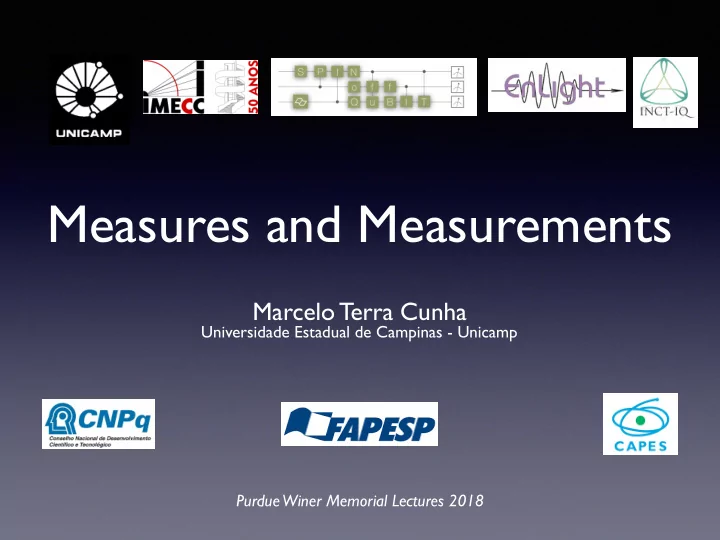

Measures and Measurements Marcelo Terra Cunha Universidade Estadual de Campinas - Unicamp Purdue Winer Memorial Lectures 2018
Starting Points • We should not run away from Probability Theory (agree with Ehtibar) • Quantum Theory is a Generalisation of Probability Theory • (Quantum) Contextuality appears as a failure of a Global Probability Space • Let us define “local” Probability Spaces and “glue them together”
Quick Review on Probability Theory A Measurable Space is a pair ( Ω , Σ ) A set, called Sample Space Ω A sigma-algebra of subsets Σ of the Sample Space
Quick Review on Probability Theory A Probability Space is a triple ( Ω , Σ , μ ) A set, called Sample Space Ω A sigma-algebra of subsets Σ of the Sample Space A probability measure on Σ μ
Remind: sigma-Algebra A family of subsets of such that Ω ∅ ∈ Σ A ∈ Σ ⟹ Ω ∖ A ∈ Σ A i ∈ Σ , i ∈ ℕ ⟹ ⋃ A i ∈ Σ ∧ ⋂ A i ∈ Σ i i
Remind: Probability Measure μ : Σ ⟶ ℝ Kolmogorov μ ( A ) ≥ 0 μ ( Σ ) = 1 A i ∩ A j = ∅∀ i , j ⟹ μ ( ⋃ A i ) = ∑ μ ( A i ) i i (countable disjoint union)
Small Detour: My understanding of Kolmogorov’s “ontology” • Sigma is the Event-Space, where “observables” live • Omega is the “Underlying Reality”, from where all “observables” are determined
The Problem • What if not all observables can be jointly defined??? • What if Compatibility Conditions should be imposed to the theory?
The Solution • Just like a manifold is obtained glueing together “pieces” of vector spaces, we can define a Probability Space for each context and glue them together!
The Solution • More precisely, we will build two fibre bundles where the fibres are: • Measurable Spaces • Probability Spaces
The Basis: Contextuality Scenarios A Pair ( 𝒴 , 𝒟 ) A Set of possible Measurements 𝒴 A Compatibility Cover, i.e. 𝒟 ⊆ 𝒬 ( 𝒴 ) 𝒟 s.t. C ∈ 𝒟 ∧ C ′ � ⊂ C ⟹ C ′ � ∈ 𝒟
A Basic Concept: Measurement A Measurement, , is characterised by ℳ the set of its possible outcomes A Realisation of is given by a ℳ Measurable Space, , with a ( Ω , Σ ) partition of , subordinated to ℳ Ω A Probability Measure for is given ℳ by a Probability Measure on Σ
Compatibility Compatible Measurements can be Realised in the same Measurable Space Thm: Measurements and are compatible ℳ 𝒪 iff there is the joint measurement ℳ ∧ 𝒪
Attaching the Fibres Given a Contextuality Scenario, , ( 𝒴 , 𝒟 ) for each maximal context, , one C attaches a Measurable Space . ( Ω C , Σ C ) Rmk: Up to this point, we have Contextuality-by-Default, as defined by Dzhafarov
Digression • Up to this moment, the contexts are isolated! There is no precise meaning in saying one measurement belongs to two (or more) different contexts • How to fix it? How to include Kochen- Specker contextuality in this framework?
Glueing Contexts For each context, will have a different realisation ℳ In , with partition { A m } m ∈ℳ ( Ω , Σ ) In , with partition { A ′ � m } m ∈ℳ ( Ω′ � , Σ′ � ) This defines a bijection for such sets: A m ↔ A ′ � m which plays the rôle of transition functions in this fibre bundle.
Empirical Models • Up to now, our fibres are Measurable Spaces • Another fibre bundle over the contextuality scenario has Probability Spaces as fibres • This we call (following Abramsky) an Empirical Model
Empirical Models Given a Contextuality Scenario, , ( 𝒴 , 𝒟 ) for each maximal context, , one C attaches a Probability Space . ( Ω C , Σ C , μ C ) New interpretation to Non-Disturbance condition!
Non-Disturbance ℳ ∈ C ∩ C ′ � ⟹ μ C ( A m ) = μ C ′ � ( A ′ � m ) In words, this is the condition for the Empirical Model to be defined on the Fibre Bundle we built by identifying the same measurements in different contexts. In other words, Non-Disturbing Empirical Model defines a Probability Bundle
Trivial Fibre Bundles • A Fibre Bundle is called trivial when it can be identified with , where is the B × F B basis and is the fibre F • A Probability Bundle is trivial when all the probability measures can be defined on the same measurable space
Classification • An Empirical Model is noncontextual when it can be described using one probability space • An Empirical Model is quantum when it can be described using one state space and Born’s rule
Fine-Abramsky- Brandenburger Thm An Empirical Model is noncontextual iff its Probability Bundle is trivial
A Lesson from Bundles • If the basis is topologically trivial, all fibre bundles are trivial • This stresses the importance of Contextuality Scenarios • And connects topology of the Scenario with the possible manifestations of contextuality
Other Lesson from Bundles: Extensions We have just interpreted non-contextuality as the possibility of extending a given empirical model to a trivial probability bundle What about other extensions?
Subscenarios Given a Scenario , we call ( 𝒴 , 𝒟 ) a Subscenario if ( 𝒴′ � , 𝒟′ � ) 𝒴′ � ⊆ 𝒴 and 𝒟′ � ⊆ 𝒟 Special Case (Induced Subscenario): For a chosen , 𝒴′ � ⊆ 𝒴 take all which are made of elements of C ∈ 𝒟 𝒴′ � Special Family (Nested Subscenarios): Fixed , nested 𝒴 Compatibility Covers gives Nested Subscenarios
Thank you!
Recommend
More recommend